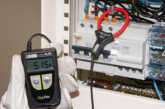
More expert advice from the team at ELECSA.
This article explains why it is necessary to determine the values of earth fault loop impedance (Zs) for new installations and for those in service that are being inspected and tested to establish their condition. The article also discusses the use of calculation as an alternative to loop impedance measurement, as permitted by BS 7671.
External earth loop impedance (Ze)
Regulation 313.1 requires a number of characteristics of the supply to an installation to be determined, including the nominal voltage to earth (U₀), the earth loop impedance of that part of the system external to the installation (Ze), and the prospective short-circuit current at the origin of the installation.
The value of external earth loop impedance (Ze) measured or otherwise determined in accordance with Regulation 313.1 may differ from the applicable typical maximum value declared by the electricity distributor, which is usually:
- 0.8 Ω for TN-S system
- 0.35 Ω for a TN-C-S system
- 21 Ω plus the resistance of the installation earth electrode for a TT system.
Earth loop impedance of final circuits
For each final circuit and distribution circuit, it must be confirmed that the value of line-earth loop impedance (Zs) is low enough to achieve automatic disconnection of supply to the circuit within the relevant maximum time specified in Regulation Group 411.3.2 in the event of an earth fault.
Table 1 gives the maximum disconnection times permitted for final circuits and distribution circuits in TN and TT systems at a nominal voltage to earth (U₀) of 230 V. When checking that the value of Zs is sufficiently low to achieve disconnection within the required maximum time, account must be taken of characteristics of the protective device used for automatic disconnection.
For commonly used overcurrent devices, this is usually done by checking that the measured value of Zs at the electrically most remote part of the circuit is not more than 80 % of the applicable maximum value given in Tables 41.2, 41.3 of 41.4 of BS 7671.
For overcurrent devices not covered by those tables, another reliable source of information on the limiting values of Zs must be consulted, such as the manufacturer’s data.
Where the protective device is a nondelayed RCD, the maximum value of Zs can be found from Table 41.5 of BS 7671. The Zs values in that table are intended for a TT system but may also be applied to a TN system. These Zs values not only meet the disconnection time requirements of BS 7671, they also meet the condition RA × I∆n ≤ 50 V given in Regulation 411.5.3 (ii) for a TT system. (RA is the sum of the resistances of the earth electrode (to Earth) and the protective conductor connecting it to the exposed conductive-part. I∆n is the rated residual operating current of the RCD.)
For RCDs not covered by Table 41.5, the maximum value of Ze can be determined from information given in Table 3A in Appendix 3 of BS 7671, by using the formula given on the same page as that table. In addition, for a TT system, Zs must be low enough to meet the condition RA × I∆n ≤ 50 V, mentioned above.
Consequences when performing earth loop impedance tests
For new installations, earth loop impedance testing should present few operational problems during the initial verification process, as the installation will not have been put into service.
However, for an installation that is in service, there may be serious consequences for the user of the premises if, for example, computer data is lost or a home life support system switched off as a result of an inadvertent interruption of supply during the test, such as might be caused by the unintended operation of an RCD.
Inadvertent disconnection of a circuit, group of circuits, distribution board or even a whole installation could occur if an RCD operates when an earth fault loop impedance test is carried out. As a result, a number of methods have been developed to minimise the likelihood of an RCD operating during such a test.
One such method, calculation, is described below. Another method is to measure the earth loop impedance with a loop test instrument that supplies a test current sufficiently low not to trip the RCD, such as 15 mA.
Determining earth loop impedance by calculation
Regulation 612.9 permits earth loop impedance to be determined by means other than measurement. Therefore, where reliable measured values are available for the external earth loop impedance (Ze) and for the loop resistance of the line and protective conductors (R₁ + R₂) of the circuit, it is permissible to derive the loop impedance of a circuit by using the following formula: Zs = Ze + (R₁ + R₂).
However, using a previously-measured value of Ze, or a value of Ze that has been determined by enquiry made with the electricity distributer, does not provide confirmation that the intended means of earthing is present and of suitably low ohmic value. Such confirmation can only be obtained by measuring the value of Ze with a loop impedance test instrument whilst the installation is isolated from the supply, and the means of earthing is disconnected from the protective bonding conductors of the installation as shown in Fig 1.
In larger, more complex installations, the value of earth loop impedance measured at a distribution board (Zdb) from which a distribution circuit or final circuit originates may be substituted for Ze in the formula above.
Further, as the loop test is being performed on the supply side of any RCD protecting the circuit in question, it should not, in most cases, cause the RCD to operate when the measurement of Ze or Zdb is taken. However, persons using this method should satisfy themselves that there is no other RCD upstream of the circuit under test, protecting for example a sub-main circuit.
Sensible precautions
The use of proprietary plug-in adaptors is recommended whenever high or low current loop impedance testing is to be carried out that would otherwise involve the use of test probes and partial dismantling (for example, to test lighting circuits in domestic premises). The use of probes to perform live tests can increase the risk of electric shock.
Regulation 14 of the Electricity at Work Regulations 1989, states that no person shall be engaged in any work activity on or so near any live conductor unless it is reasonable for such work to be done, and suitable precautions to be prevent injury through electric shock have been taken. The term ‘work’ is not solely confined to electrical work but includes any work activity, such as electrical testing.










